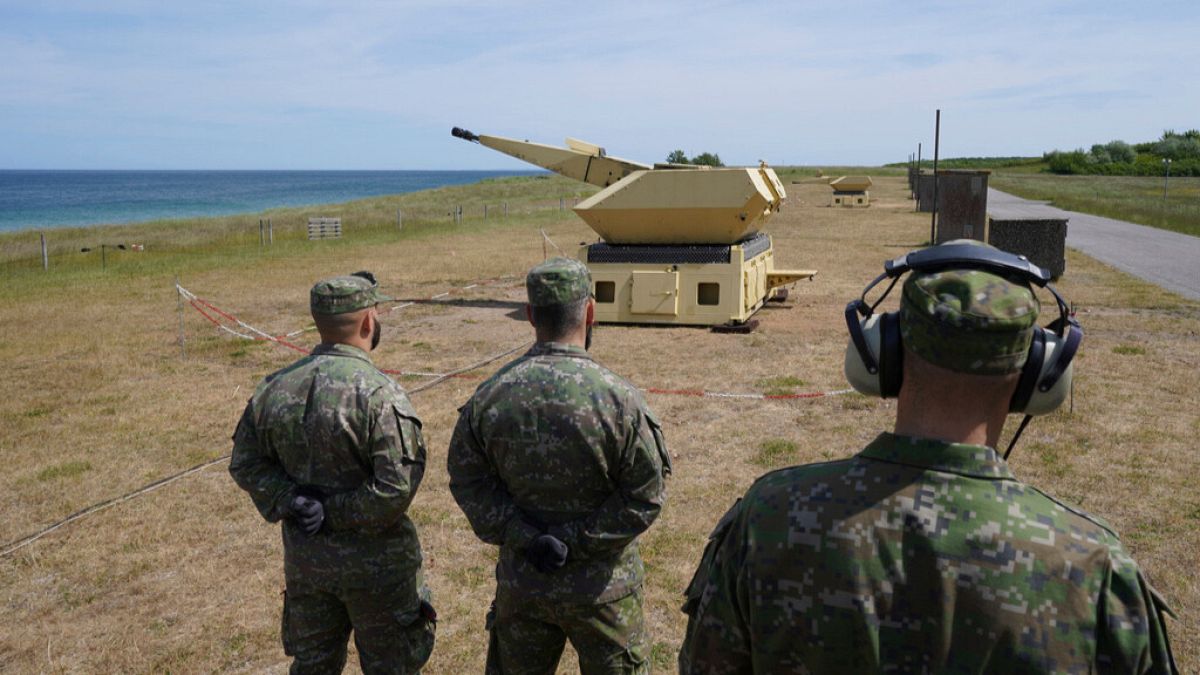Education
The Next Affirmative Action Battle May Be at West Point

Students for Fair Admissions, fresh off its Supreme Court victory gutting affirmative action in college admissions, is preparing for another potential lawsuit.
The group is soliciting possible plaintiffs — applicants rejected from the U.S. Military Academy, known as West Point; the Naval Academy; and the Air Force Academy — for an effort to challenge race-conscious admissions at the three major American service academies, which are responsible for educating and training many of the country’s future military leaders.
“Were you rejected from West Point?” asks a new webpage, WestPointNotFair.org, set up on Thursday and apparently aimed at white and Asian applicants. “It may be because you’re the wrong race.” It goes on to urge, “Tell us your story,” and provides a form requesting detailed contact information.
Affirmative action at U.S. military academies was not addressed by the Supreme Court ruling in June, because Chief Justice John Roberts wrote, in a footnote, that they had “potentially distinct interests.”
The federal government argued in its brief to the court that race-conscious admissions in the military was needed to create a pipeline of Black and Hispanic officers, and maintain morale among the troops. Racial integration in the military is a matter of national security, the government said.
“The nation’s military leaders, for example, have learned through hard experience that the effectiveness of our military depends on a diverse officer corps that is ready to lead an increasingly diverse fighting force,” the government said.
Students for Fair Admissions said in a statement that “the culture of the armed services requires that each warfighter see fellow warfighters as totally committed teammates, where race, ethnicity and heritage, while respected, do not matter.” Opponents of racial preferences in the service academies argued that they worked against efforts to defend the country.
“The military’s use of racial preferences today is unquestionably harmful to our national security,” said Veterans for Fairness and Merit, representing more than 600 former members of all branches of the U.S. military, in a brief supporting Students for Fair Admissions in the Supreme Court case.
In response to the Students for Fair Admissions criticism, the Defense Department said that it was still evaluating the implications of the court’s affirmative action decision. “We rely on a pipeline of highly qualified American patriots from all walks of life and all backgrounds, which is crucial for our national security,” it said in a statement.
The U.S. armed forces rely on a race-conscious admissions system both in admitting students to the military academies and in recruiting officers from civilian universities like Harvard, according to the government brief.
In 1968, there were 30 African American cadets at West Point; by 1971, there were almost 100, according to court papers.
West Point’s incoming class of 2027 includes 127 African Americans, 137 Hispanic Americans, 170 Asian Americans and 18 Native Americans, out of a class of about 1,240.
The service academies are highly selective, with incoming classes winnowed from a pool of 10,000 or more applicants, according to federal data. Applicants are required to meet academic and fitness requirements and be nominated, typically by a member of Congress. Tuition is free, but, in return, graduates have to serve in the military.
The question of how to handle racial preferences in the military has come up before, notably in Grutter v. Bollinger, a 2003 case in which the Supreme Court upheld the University of Michigan Law School’s use of race in admissions.
In that case, high-ranking officers and civilian leaders of the military argued in an amicus brief that the military could not achieve an officer corps that was highly qualified and racially diverse without using limited race-conscious recruiting and admissions policies in both the service academies and R.O.T.C.
The brief in the 2003 case cited the Vietnam War era as an illustration of the dangers of having too few minority officers in the military. At the end of the war, the brief said, only 3 percent of Army officers were Black.
“The danger this created was not theoretical,” it said. “As that war continued, the armed forces suffered increased racial polarization, pervasive disciplinary problems and racially motivated incidents in Vietnam and on posts around the world.”

Education
Four Fraternity Members Charged After a Pledge Is Set on Fire

Four fraternity members at San Diego State University are facing felony charges after a pledge was set on fire during a skit at a party last year, leaving him hospitalized for weeks with third-degree burns, prosecutors said Monday.
The fire happened on Feb. 17, 2024, when the Phi Kappa Psi fraternity held a large party at its house, despite being on probation, court documents show. While under probation, the fraternity was required to “demonstrate exemplary compliance with university policies,” according to the college’s guidelines.
Instead, prosecutors said, the fraternity members planned a skit during which a pledge would be set on fire.
After drinking alcohol in the presence of the fraternity president, Caden Cooper, 22, the three younger men — Christopher Serrano, 20, and Lars Larsen, 19, both pledges, and Lucas Cowling, 20 — then performed the skit, prosecutors said.
Mr. Larsen was set on fire and wounded, prosecutors said, forcing him to spend weeks in the hospital for treatment of third-degree burns covering 16 percent of his body, mostly on his legs.
The charges against Mr. Cooper, Mr. Cowling and Mr. Serrano include recklessly causing a fire with great bodily injury; conspiracy to commit an act injurious to the public; and violating the social host ordinance. If convicted of all the charges, they would face a sentence of probation up to seven years, two months in prison.
Mr. Larsen himself was charged. The San Diego County District Attorney’s office said that he, as well as Mr. Cooper and Mr. Cowling, also tried to lie to investigators in the case, deleted evidence on social media, and told other fraternity members to destroy evidence and not speak to anyone about what happened at the party.
All four men have pleaded not guilty.
Lawyers representing Mr. Cooper and Mr. Cowling did not immediately respond to messages requesting comment on Tuesday. Contact information for lawyers for Mr. Serrano and Mr. Larsen was not immediately available.
The four students were released on Monday, but the court ordered them not to participate in any fraternity parties, not to participate in any recruitment events for the fraternity, and to obey all laws, including those related to alcohol consumption.
The university said Tuesday that it would begin its own administrative investigation into the conduct of the students and the fraternity, now that the police investigation was complete.
After it confirmed the details, the dean of students office immediately put the Phi Kappa Psi chapter on interim suspension, which remains in effect, college officials confirmed on Tuesday.
Additional action was taken, but the office said it could not reveal specifics because of student privacy laws.
“The university prioritizes the health and safety of our campus community,” college officials said in a statement, “and has high expectations for how all members of the university community, including students, behave in the interest of individual and community safety and well-being.”
At least half a dozen fraternities at San Diego State University have been put on probation in the last two years, officials said.
Education
Video: Several Killed in Wisconsin School Shooting, Including Juvenile Suspect

new video loaded: Several Killed in Wisconsin School Shooting, Including Juvenile Suspect
transcript
transcript
Several Killed in Wisconsin School Shooting, Including Juvenile Suspect
The police responded to a shooting at a private Christian school in Madison, Wis., on Monday.
-
Around 10:57 a.m., our officers were responding to a call of an active shooter at the Abundant Life Christian School here in Madison. When officers arrived, they found multiple victims suffering from gunshot wounds. Officers located a juvenile who they believe was responsible for this deceased in the building. I’m feeling a little dismayed now, so close to Christmas. Every child, every person in that building is a victim and will be a victim forever. These types of trauma don’t just go away.
Recent episodes in Guns & Gun Violence
Education
Video: Biden Apologizes for U.S. Mistreatment of Native American Children

new video loaded: Biden Apologizes for U.S. Mistreatment of Native American Children
transcript
transcript
Biden Apologizes for U.S. Mistreatment of Native American Children
President Biden offered a formal apology on Friday on behalf of the U.S. government for the abuse of Native American children from the early 1800s to the late 1960s.
-
The Federal government has never, never formally apologized for what happened until today. I formally apologize. It’s long, long, long overdue. Quite frankly, there’s no excuse that this apology took 50 years to make. I know no apology can or will make up for what was lost during the darkness of the federal boarding school policy. But today, we’re finally moving forward into the light.
Recent episodes in Politics
-

 Business1 week ago
Business1 week agoThese are the top 7 issues facing the struggling restaurant industry in 2025
-

 Culture1 week ago
Culture1 week agoThe 25 worst losses in college football history, including Baylor’s 2024 entry at Colorado
-

 Sports1 week ago
Sports1 week agoThe top out-of-contract players available as free transfers: Kimmich, De Bruyne, Van Dijk…
-

 Politics6 days ago
Politics6 days agoNew Orleans attacker had 'remote detonator' for explosives in French Quarter, Biden says
-

 Politics5 days ago
Politics5 days agoCarter's judicial picks reshaped the federal bench across the country
-

 Politics4 days ago
Politics4 days agoWho Are the Recipients of the Presidential Medal of Freedom?
-

 Health3 days ago
Health3 days agoOzempic ‘microdosing’ is the new weight-loss trend: Should you try it?
-

 World1 week ago
World1 week agoIvory Coast says French troops to leave country after decades














